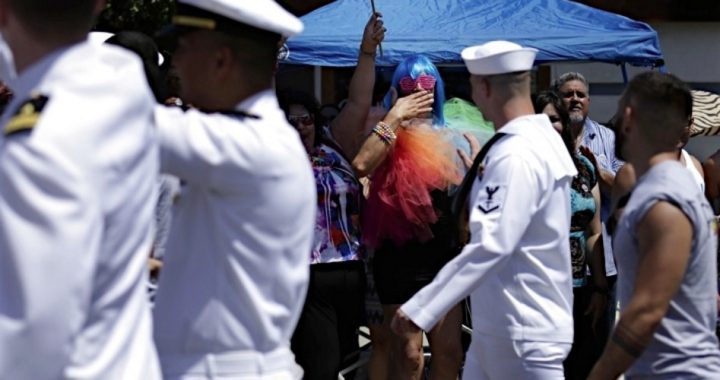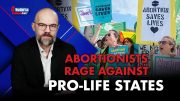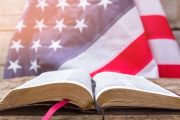
The U.S. Department of Defense (DOD) appears to be bending over backwards to make certain that homosexuals feel accepted and valued in the military. On July 21, Defense Secretary Leon Panetta permitted active duty military personnel to march in uniform in San Diego’s notorious “gay pride” parade, the first time such an allowance has been made.
In a June 19 memorandum, the Defense Department announced that Panetta would allow troops to march in the parade even though military policy generally disallows active personnel from marching in uniform in parades. According to the Associated Press, the DOD caved in to pressure because organizers of the San Diego event “had encouraged military personnel to march in their uniform and the event was getting national attention.”
As reported by The New American, in June Panetta and the Pentagon joined homosexual troops in marking June as “gay pride” month. In a June 15 video message Panetta thanked “gay” military personnel for their service to the nation — both during and since the repeal of “Don’t Ask, Don’t Tell” (DADT), the Defense Department policy that had officially banned homosexuals from military service. “As we recognize pride month, I want to personally thank all of our gay and lesbian service members, LGBT civilians and their families for their dedicated service to our country,” Panetta said. “Before the repeal of Don’t Ask, Don’t Tell,’ you faithfully served your country with professionalism and courage. And just like your fellow service members, you put your country before yourself. And now after the repeal, you can be proud of serving your country and be proud of who you are in uniform.”
“Last year San Diego’s gay pride parade had the nation’s largest contingency of active-duty troops participate before the military lifted its ban on openly gay service members,” reported the AP. “About 200 service members last year wore T-shirts with their branch’s name.” But one of the parade organizers, Sean Sala, himself a former sailor, had pushed for this year’s parade to include active duty personnel wearing their uniforms as a statement that homosexual troops had nothing to hide. “My soul is on fire,” Sala cried upon hearing that the DOA would make allowances this year. “They don’t fight in T-shirts. They fight in uniforms. This is about showing who they are.”
While the Pentagon stipulated that the allowance for personnel to march in uniform (they don’t need permission to march in civilian clothes) is only for this year, Sala predicted that the Pentagon’s concession will be permanent. “I think across the country we will start seeing active-duty members in uniform march in pride parades,” he said.
The AP noted that uniformed soldiers in Canada and Great Britain “have marched down the streets of Toronto and London next to scantily clad men, drag queens and civil rights activists” in similar parades. More than 300 active duty personnel had indicated they would march in this year’s San Diego event, and while a YouTube video of the parade clearly shows a handful marching in uniform, many more individuals marched in T-shirts with specific service branches emblazoned across the fronts.
“Today is so important,” bubbled Navy Lieutenant Brian McKinney, who participated in the parade with his same-sex partner. “It’s about putting on my uniform and taking pride in my service, my fellow service-members, my family, and myself. It’s something I’m incredibly thankful for.”
Similarly, reported the Washington Post, Navy Commander Kent Blade, “who will retire this fall after 26 years in the Navy, said being able to march in uniform was a perfect culmination of his career. The 47-year-old said that since last year’s repeal of the ‘don’t ask, don’t tell’ law, he has received unconditional support from his fellow officers. ‘We’ve all been able to talk more freely about our lives. Nobody’s leading a second life,’ he said. ‘And now that I can march freely in uniform, I think it’s a great display for the Navy.’
Peculiarly, while the Defense Department appears to be okay with soldiers appearing in uniform at events endorsing a lifestyle that was banned in the military for over 200 years, it frowns on uniformed personnel appearing at traditional events re-affirming America’s political liberties. As reported in March by the Des Moines Register, the U.S. Army Reserve reprimanded one of its soldiers, Jesse Thorsen, after he appeared on national television in his military uniform to endorse Ron Paul for president on the night of the Iowa caucuses. According to the Register, the military announced that Thorsen had violated Department of Defense policies when he appeared with Paul at a January 3 rally.
“Paul’s aides have said the candidate invited Thorsen to the stage after he gave a television interview earlier that was cut off because of technical difficulties,” reported the Register. “The U.S. Army Reserve launched an investigation and distanced itself from his political views.”
As with parades, military personnel are officially banned from appearing in uniform at political events (a rule Thorsen most likely was not aware of). The DOD made special allowance for the personnel marching in the San Diego homosexual parade, but offered no similar concession for Thorsen’s apparent slip.
The New American noted that since the September 2011 repeal of DADT, “the integration of an openly homosexual sub-culture within America’s armed forces has moved forward at breakneck speed.” The once-underground Outserve, a contingent of homosexual activists within the U.S. military, has been given an unofficial nod of approval from DOD and claims that its membership has blossomed to 5,500 active-duty members.
And at West Point, once a bastion of squared-away military discipline, “the alumni gay advocacy group Knights Out was able to hold the first installment in March of what is intended to be an annual dinner in recognition of gay and lesbian graduates and Army cadets,” reported the Associated Press. Similarly, “gay students at the U.S. Naval Academy were able to take same-sex dates to the academy’s Ring Dance for third-year midshipmen.”
Observed Air Force officer Josh Seefried, one of OutServe’s spokespersons, of the increasing saturation of America’s military with homosexual sensibilities: “I don’t think it’s just moving along smoothly — I think it’s accelerating faster than we even thought the military would as far as progress goes.”
Photo: A man blows a kiss to Navy sailors marching in uniform during the gay pride parade, July 21, 2012, in San Diego: AP Images



